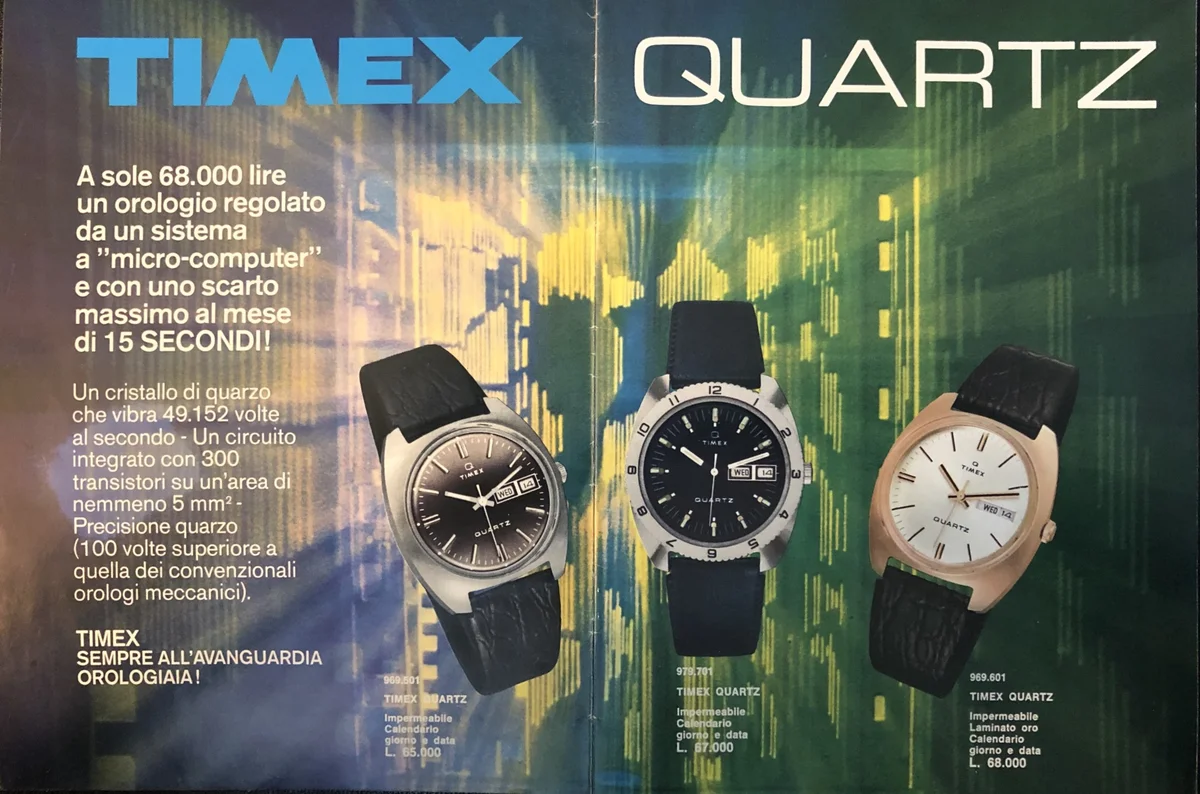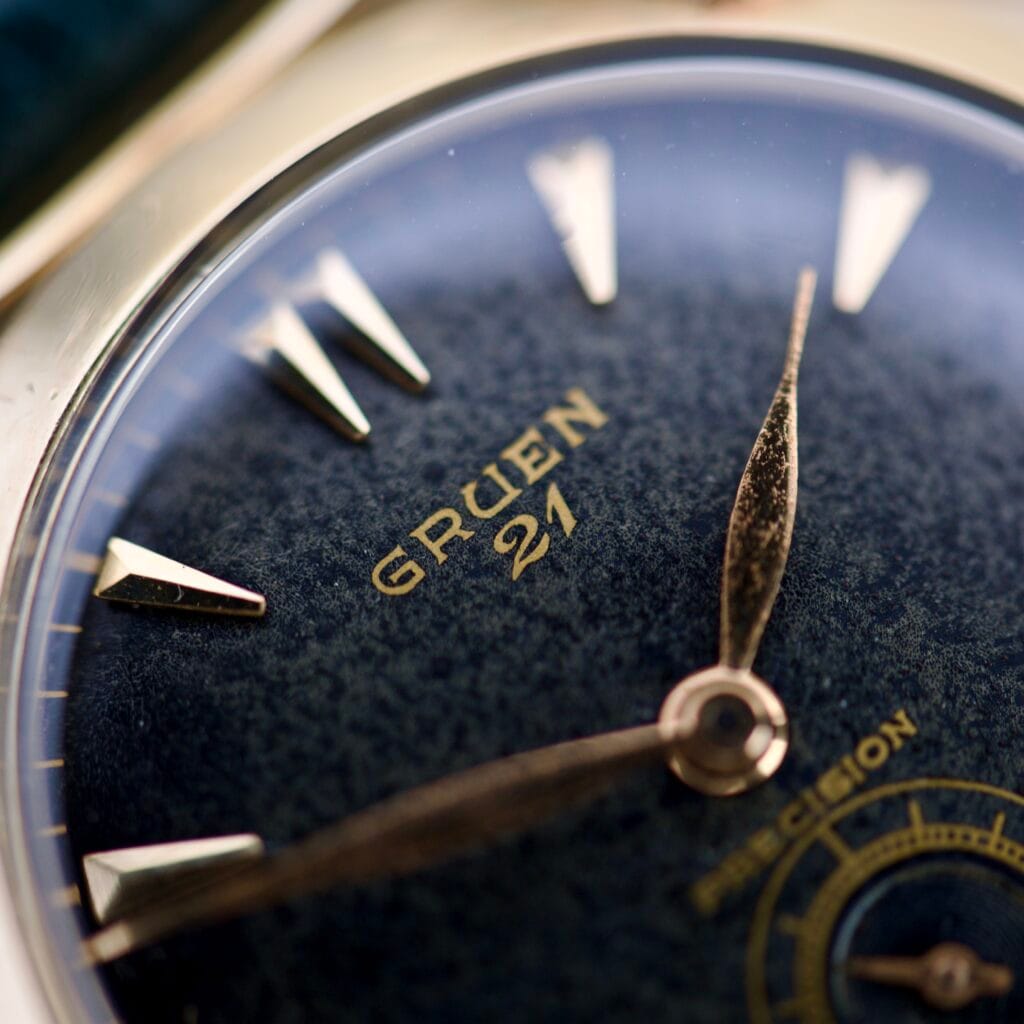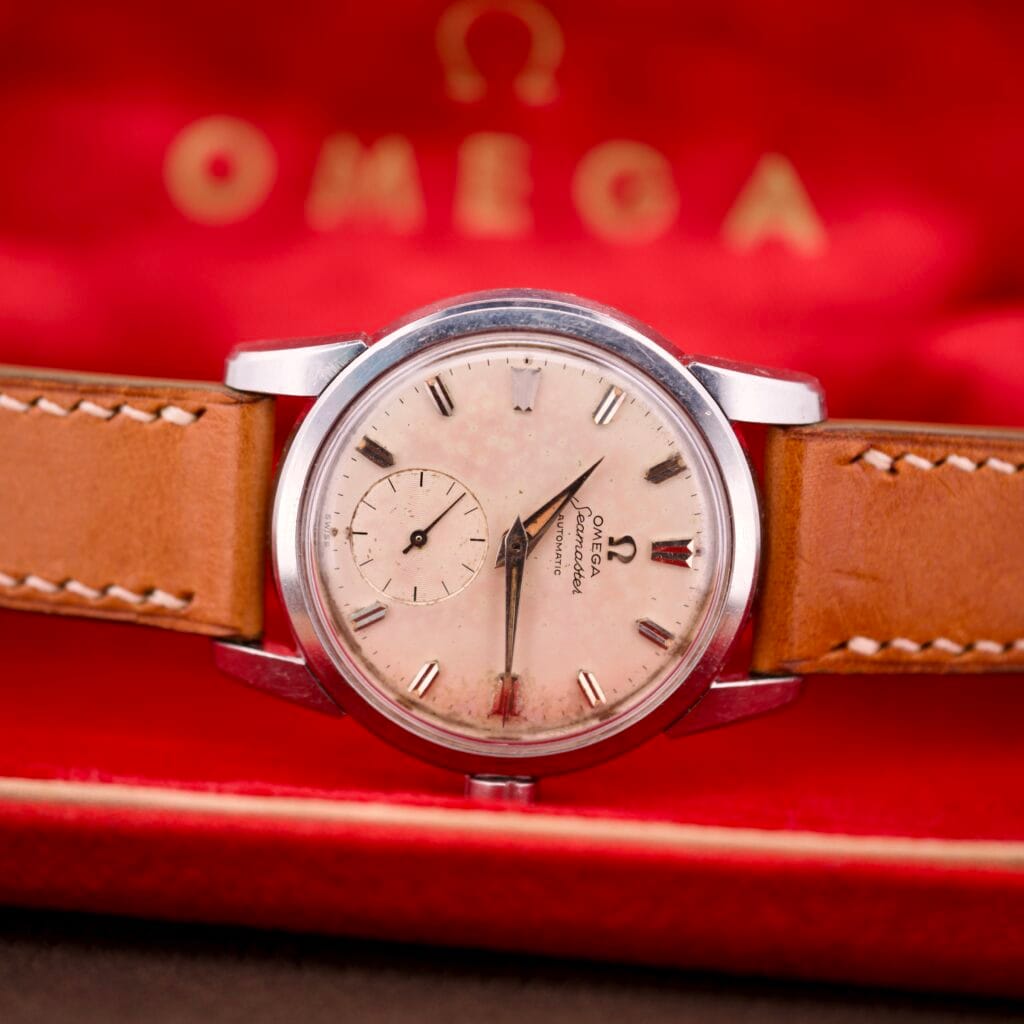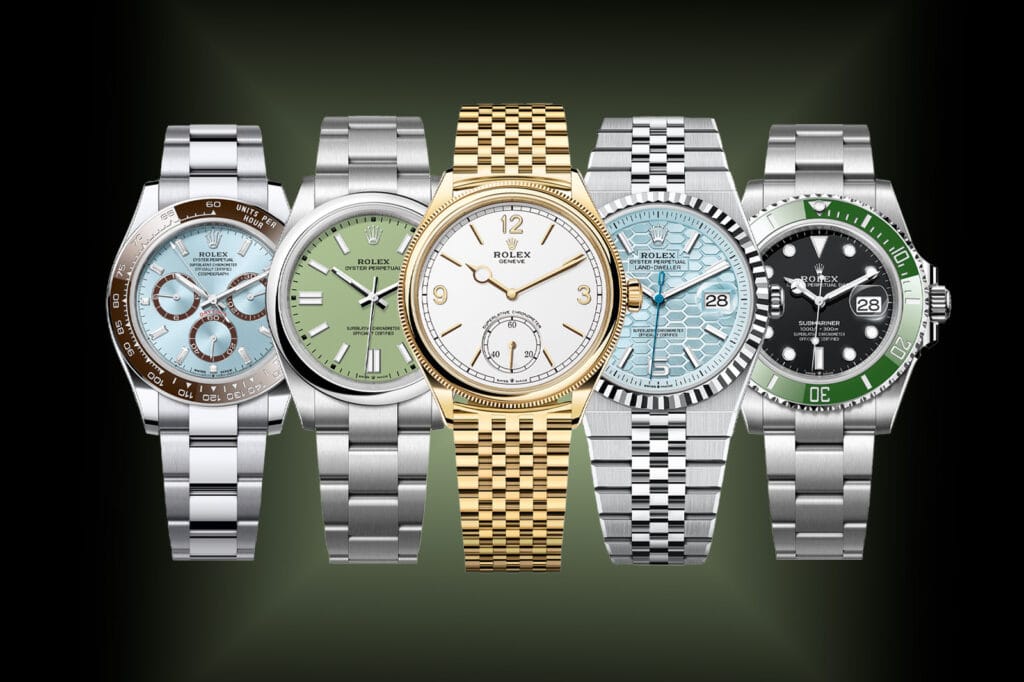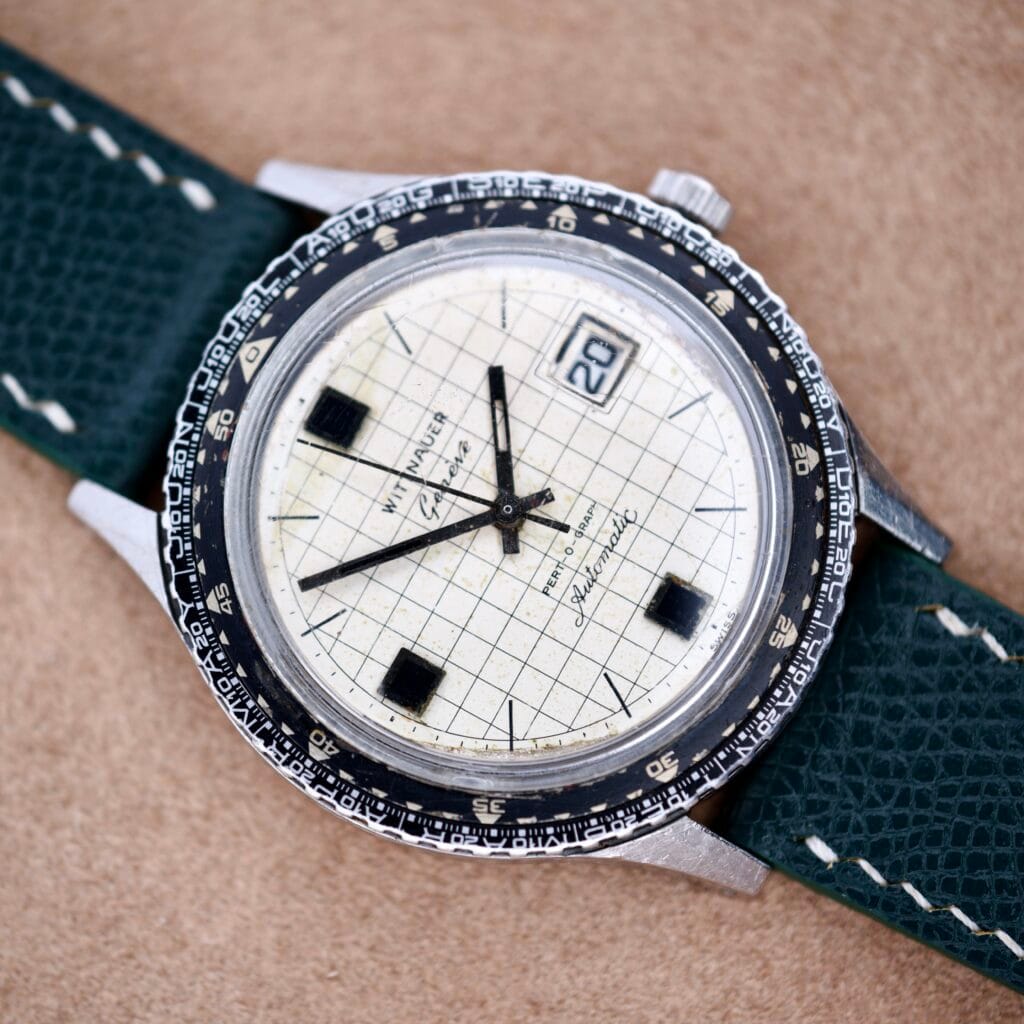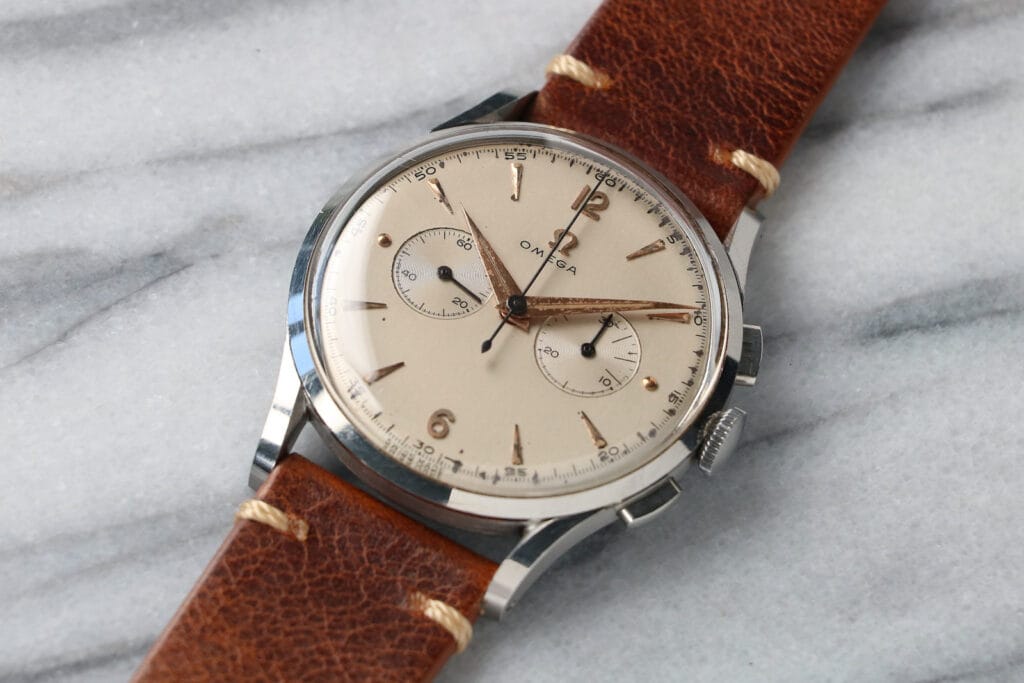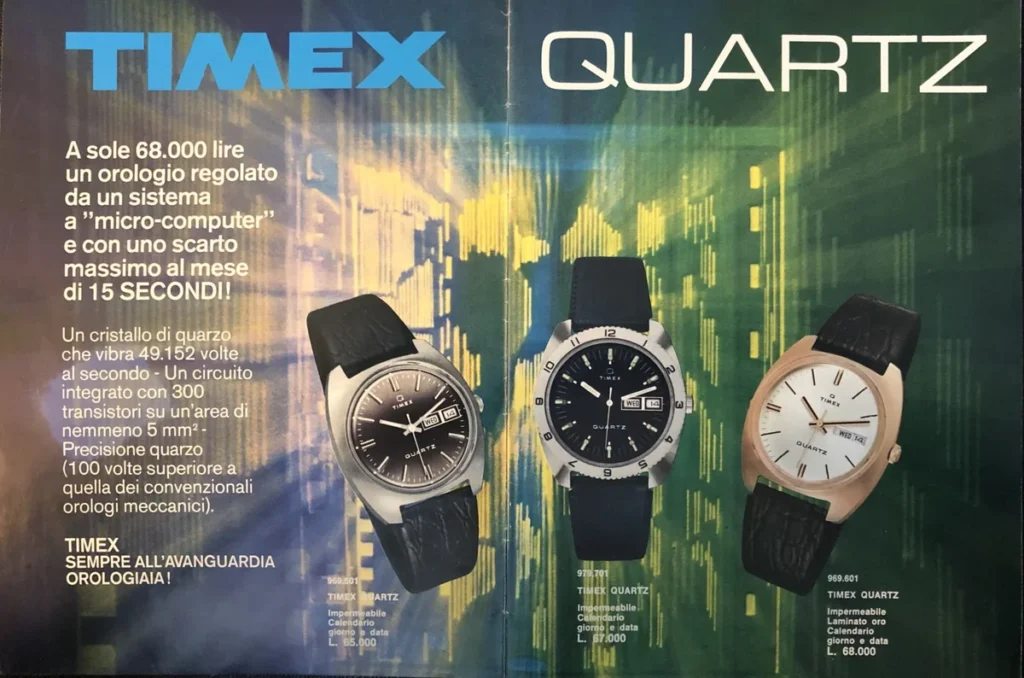Don't miss the next drop
Before the quartz crisis (1970s), the Swiss watchmaking industry stood as an unshakeable colossus, a global symbol of precision, intricate craftsmanship, and enduring tradition. Its name was synonymous with quality, its mechanisms the gold standard in horology. Yet, beneath this veneer of invincibility, the gears of a revolution were quietly turning. This revolution, powered by a tiny, vibrating crystal, would unleash what became known as the “Quartz Crisis” – a technological tsunami that threatened to engulf centuries of Swiss heritage.
The term, quartz crisis, however, reveals a crucial duality: for the Swiss, it was undeniably a crisis, an existential threat to their economic and cultural identity. But for others, particularly in Japan and the United States, it was a “quartz revolution,” an era of unprecedented innovation and market opportunity. This is the story of that upheaval – a narrative of innovation challenging tradition, of hubris meeting disruption, of a near-fatal collapse, and ultimately, of a remarkable reinvention that forever changed the landscape of time.
Swiss Watchmaking’s Golden Age (Pre-1970s)
In the decades leading up to the 1970s, Swiss watchmaking enjoyed a period of unparalleled global dominance. The statistics are staggering: Swiss manufacturers commanded approximately 50% of the entire world watch market and were responsible for an astonishing 95% of all watches produced globally. This was more than just market share; it was a cornerstone of Switzerland’s economy and a deep-seated part of its national identity. Swiss watches were universally perceived as the pinnacle of quality, luxury, and enduring value, their intricate mechanical movements a testament to generations of accumulated skill.
Several factors contributed to this golden age. A long and storied tradition of meticulous craftsmanship had established a reputation for excellence. However, a critical, perhaps defining, factor was Switzerland’s neutrality during World War II. While the industrial capacities of other major watchmaking nations like the United States and Japan were diverted to producing military ordnance and timing devices for the war effort, Swiss factories continued to manufacture consumer timepieces. This created a post-war vacuum in the global market, particularly in the booming American economy, which Swiss manufacturers expertly filled, effectively achieving a near-monopoly. By 1960, Swiss companies held a 60% share of the US watch market.
This prolonged period of dominance, however, may have inadvertently sown the seeds of vulnerability. When an industry enjoys such an “effective monopoly” with minimal competition, the urgency to pursue radical innovation or adapt to nascent external threats can diminish. The very success of the existing mechanical paradigm made a fundamental shift seem not only unnecessary but potentially disruptive to a highly profitable status quo. Furthermore, the Swiss industry’s identity and strength were profoundly intertwined with mechanical technology. This deep-rooted tradition, while a source of pride and quality, would soon become its Achilles’ heel when confronted by a technology that was not just different, but fundamentally more efficient for the core task of timekeeping.

The Electronic Heartbeat: Dawn of the Quartz Revolution
The scientific principle that would challenge the reign of gears and springs was deceptively simple. Certain quartz crystals, when a voltage is applied, oscillate (vibrate) at an exceptionally precise and stable frequency. This phenomenon offered a new, potentially far more accurate, basis for timekeeping than the traditional mechanical balance wheel.
The journey from scientific principle to wristwatch began decades earlier. The first quartz clock was invented in 1927 by Warren Marrison in the United States, followed by Japan’s first, developed by Issac Koga, in 1937. However, it was the Japanese company Seiko that embarked on the pivotal research to miniaturize this technology. In 1958, Seiko began developing large quartz clocks for broadcasting stations. Recognizing the immense future potential, despite the daunting technical challenges of miniaturization (reducing the size by a factor of 300,000), Seiko initiated a dedicated research project in 1959 to create a quartz wristwatch. This sustained, decade-long commitment to research and development proved crucial.
The culmination of Seiko’s efforts arrived on December 25, 1969, with the launch of the Seiko Quartz Astron 35SQ – the world’s first commercially available quartz wristwatch. It was a landmark achievement. The Astron boasted an accuracy of ±5 seconds per month, roughly 100 times more accurate than the finest mechanical chronometers of the day. Initially, this groundbreaking technology came at a steep price: the first gold-cased Astrons cost 450,000 Yen, equivalent to the price of a small car.
The Swiss were not entirely idle. In 1962, a consortium of approximately 21 leading Swiss watch companies, including prestigious names like Patek Philippe, Omega, and Rolex, formed the Centre Electronique Horloger (CEH) in Neuchâtel to collaboratively research and develop electronic watch technology. Their answer to the quartz challenge was the Beta 21 movement. Prototypes emerged in 1967, and watches equipped with the Beta 21 were commercially launched in 1970. These, too, were positioned as high-tech, luxury items. For instance, Patek Philippe’s first Beta 21 model, the reference 3587, retailed for a significant $3,500 USD in 1969 – more than their highly complicated mechanical perpetual calendar chronographs like the reference 2499.
Despite these parallel developments, a crucial difference in approach emerged. The Swiss industry, deeply entrenched in its mechanical heritage and enjoying market dominance, was slow to fully embrace quartz technology or market it aggressively to the masses. They largely continued to focus on their traditional mechanical watches, perhaps viewing quartz as an interesting but niche technological advancement rather than a paradigm-shifting force. The Beta 21 movement itself, while an achievement, was also noted for being larger, heavier, and more power-hungry than its emerging Japanese counterparts.
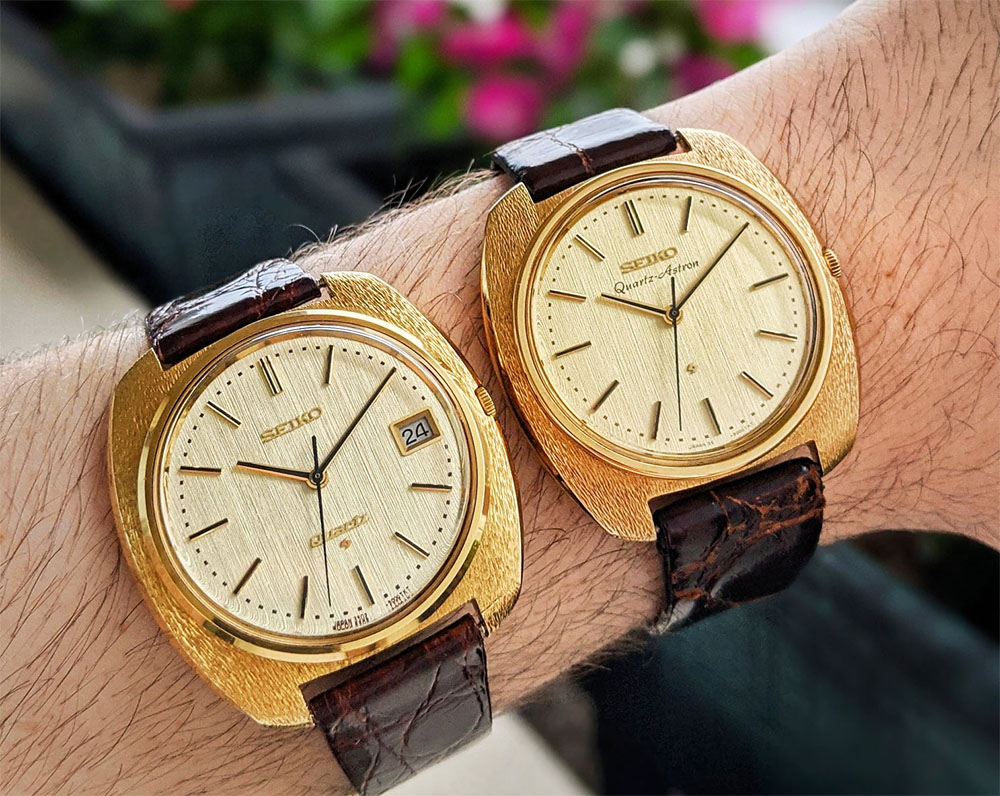
This hesitation can be partly attributed to a cultural inertia, a deep-seated belief in the inherent superiority and tradition of mechanical craftsmanship. To many within the Swiss establishment, prioritizing quartz might have felt like a betrayal of their very identity. There was also a fundamental misjudgment of the ultimate value proposition of quartz. While the Swiss initially positioned their quartz offerings as expensive, high-tech marvels for the elite , they failed to foresee the Japanese strategy that would soon unfold: the mass production of highly accurate, reliable, and, crucially, affordable quartz watches. This Japanese approach would redefine what “value” meant for the average watch consumer, shifting the focus from intricate mechanics to accessible precision.
The Swiss Industry Crumbles (1970s – Early 1980s)
The 1970s witnessed a seismic shift in the global watch market. Japanese companies, spearheaded by Seiko, Citizen, and Casio, along with American firms for a period, wholeheartedly embraced quartz technology. They invested heavily not just in the technology itself, but in mass production techniques, including automation, to bring quartz watches to a global audience at increasingly competitive prices. Seiko, in particular, leveraged its early lead and commitment to automated production lines.
The impact was swift and brutal for the traditional watchmaking world. By 1977, a mere eight years after the Astron’s debut, Seiko had ascended to become the world’s largest watch company by revenue, with sales reaching $700 million from 18 million units produced. The following year, 1978, marked a tipping point: quartz watches globally overtook mechanical watches in popularity. By 1979, quartz models already accounted for approximately 55% of Japan’s substantial annual watch production of 60 million units.
For Switzerland, the consequences were devastating. The industry, once seemingly impregnable, began to crumble. The sheer scale of the devastation is starkly illustrated by key statistics:
The Swiss Watch Industry’s Ordeal – quartz crisis
| Metric | Pre-Crisis (c. 1970) | Crisis Low-Point (c. 1983-1984) | Post-Recovery (c. 1988) |
|---|---|---|---|
| Number of Watchmaking Companies | 1,600 | 600 (by 1983) / <600 (by mid-1980s) | N/A (focus on employment for recovery) |
| Employment in Watchmaking | 90,000 | 33,000 (by 1984) | 28,000 (by 1988) |
| Swiss Share of Global Market | ~50% | Dramatically reduced (specific figure for low point not consistently available) | Regaining, but different structure |
| Annual Watch Exports (Units) | 40 million mechanicals (1973) / 96 million total (1974) | 3 million mechanicals (by 1983) / Total exports halved from 1974 peak by early 1980s | Rebounding, Swatch effect (60M total 1985, 80% quartz) |
Many once-profitable and famous Swiss watch houses became insolvent or disappeared entirely. By the early 1980s, the Swiss watch industry was described by some observers as “virtually dead”.
This crisis was not solely a result of technological disruption; it was a “perfect storm.” Several external factors exacerbated the situation. The global economic instability following the oil crisis of the early 1970s made consumers worldwide more price-conscious, favoring the increasingly affordable quartz watches. Compounding this, the Swiss Franc began to appreciate sharply against the US Dollar after the collapse of the Bretton Woods system in 1971. This made Swiss exports, already relatively expensive, significantly less competitive in key markets like the United States. For instance, the Franc surged 29% against the dollar in just 18 months from early 1972. Internally, rising production costs, including labor, within Switzerland further squeezed margins. The fragmented nature of the Swiss industry, with many independent players, also led to a lack of cohesive strategy and a delayed, often uncoordinated, response to the rapidly changing market dynamics.
The Japanese firms, on the other hand, possessed significant strategic advantages. Companies like Seiko not only innovated in quartz technology but also mastered mass production and vertical integration – making nearly every component themselves – which allowed for greater efficiency and cost control. Their marketing, too, was astute, emphasizing the tangible benefits of precision and value, which resonated strongly with a new generation of consumers.
Beyond the staggering economic losses, the Quartz Crisis inflicted a deep psychological blow upon Switzerland. Watchmaking was, and is, intrinsically linked to Swiss national identity, a source of immense pride and a symbol of the nation’s engineering prowess and commitment to quality. The sudden and dramatic erosion of this legacy was profoundly unsettling, likely contributing to the initial paralysis and difficulty the industry experienced in formulating an effective counter-strategy. It was a crisis that struck at the very heart of Swiss self-perception.
The Swiss Counterstrike
By 1983, the Swiss watch industry had reached a nadir. The number of watchmakers had plummeted, and employment had been decimated. It was at this critical juncture that Nicolas G. Hayek, a charismatic and visionary management consultant, was commissioned by beleaguered Swiss banks to analyze the situation and propose a path forward.
Hayek’s audacious vision centered on radical consolidation and a complete reimagining of what a Swiss watch could be. The fragmented nature of the industry, with its two largest but struggling conglomerates – ASUAG (Allgemeine Schweizerische Uhrenindustrie AG, a major producer of movements and parts, owning brands like Longines, Rado, and the crucial movement manufacturer ETA) and SSIH (Société Suisse pour l’Industrie Horlogère, which owned Omega, Tissot, and Lemania) – was a primary weakness. Hayek orchestrated their merger in March 1983, creating ASUAG/SSIH. This entity was subsequently renamed SMH (Société de Microélectronique et d’Horlogerie) in 1986, and ultimately The Swatch Group in 1998. Hayek, along with a group of Swiss investors, took a majority shareholding in the new conglomerate in 1985 and assumed the roles of Chairman and CEO in 1986. A key strategic move within this consolidation was centralizing movement production under ETA, which was retooled to efficiently produce affordable analog quartz movements, supplying not only the group’s brands but others as well.
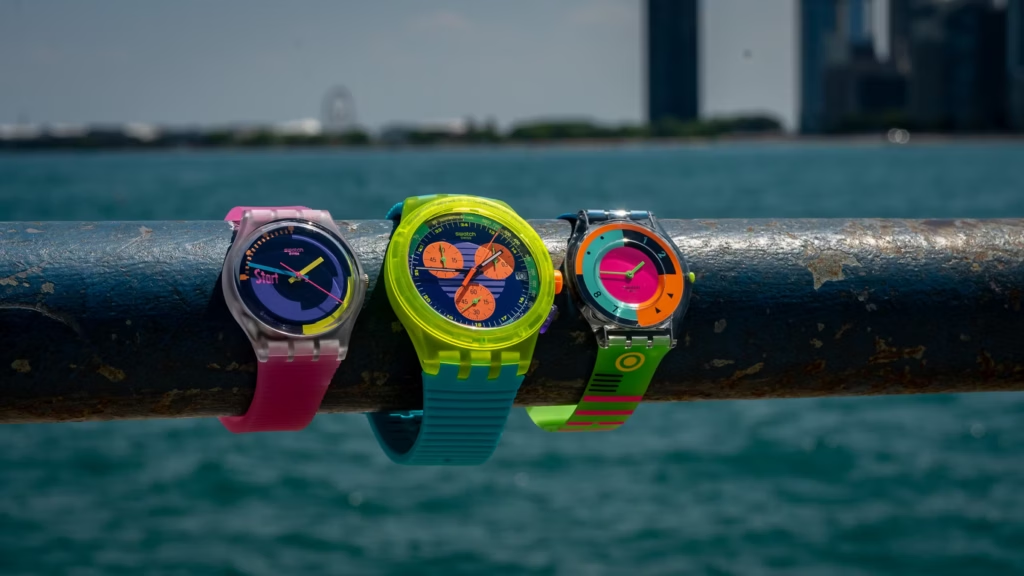
The cornerstone of Hayek’s revival strategy was a product that shattered every convention of Swiss watchmaking: the Swatch. Developed under the leadership of then-ETA CEO Ernst Thomke, with a core team of engineers including Elmar Mock and Jacques Müller, and pushed towards a fashionable concept by marketing consultant Franz Sprecher, the Swatch was launched on March 1, 1983, in Zürich.
The Swatch was revolutionary. Its name, a contraction of “second watch,” encapsulated its concept: an affordable, high-tech, artistic, and emotional timepiece marketed as a casual, almost disposable, fashion accessory. The design was a radical departure: a vibrant plastic case, significantly fewer moving parts (around 51 compared to approximately 91 in a typical mechanical watch), and a production process that was largely automated, ensuring cost-efficiency and higher profitability. Priced initially between CHF 39.90 and CHF 49.90, later standardized at CHF 50.00, it was unprecedentedly inexpensive for a Swiss-made watch.
The marketing was equally bold and unconventional, targeting a younger, fashion-conscious demographic with playful and provocative campaigns. It competed directly with Japanese quartz watches on price but offered the cachet of “Swiss Made” coupled with a vibrant, ever-changing array of designs.
The success was immediate and phenomenal. More than 2.5 million Swatches were sold in under two years. By 1986, cumulative sales reached 23 million, and by 1992, an astounding 100 million Swatches had been sold. The Swatch became a global pop culture icon. This triumph did more than just generate revenue; it provided a vital financial lifeline that supported the revival of the traditional luxury brands within the SMH conglomerate (a strategy often referred to as the “Hayek Pyramid”). Swiss watch production, which had plummeted to 45 million units in 1983, rebounded to 60 million units within two years of Swatch’s introduction, with 80% of these now being quartz watches. The Swiss banks also played a crucial role, injecting over 550 million Swiss francs into the ailing industry between 1981 and 1983, providing the capital necessary for restructuring and innovation.
The Swatch was not merely a new product; it was a radical reimagining of the Swiss watch. By targeting an entirely new market segment with a product that broke all traditional Swiss molds, Hayek found a way to compete where traditional mechanicals could not. This was a masterstroke in market segmentation, leveraging Swiss branding in an entirely novel and accessible way. The strategic consolidation into SMH was equally vital. A fragmented industry would have struggled to mount such a coordinated and ambitious response. Centralization allowed for rationalized production, focused marketing, and the necessary scale for a venture like Swatch. Above all, the leadership of Nicolas G. Hayek proved indispensable. His “visionary,” “radical,” and “unconventional” approach was not about managing decline but actively reshaping the industry’s future by challenging entrenched norms and taking calculated, bold risks.
The Mechanical Renaissance
Even as the Swatch and other quartz watches conquered the mass market with their affordability and precision, a fascinating counter-movement began to stir within the watch world. As quartz technology democratized accurate timekeeping, making such watches ubiquitous and often inexpensive , the very nature and perception of the traditional mechanical watch started to transform.
No longer solely utilitarian tools for telling time, mechanical watches were gradually and strategically repositioned. They became potent symbols of something more intangible: exquisite craftsmanship, deep-rooted artistry, and a rich historical heritage. They evolved into signifiers of luxury, exclusivity, and status, appealing to a desire for tangible complexity and enduring value in an increasingly electronic world. For many, they evoked an emotional connection, a “romanticism” associated with the intricate dance of miniature gears and springs.
A pivotal figure in this mechanical renaissance was Jean-Claude Biver. In 1981/1982, alongside Jacques Piguet (owner of the esteemed movement manufacturer Frédéric Piguet), Biver acquired the rights to the then-dormant Blancpain brand for a mere CHF 22,000. At a time when the industry was still reeling from the quartz onslaught, Biver’s strategy for Blancpain was defiantly traditionalist yet brilliantly forward-thinking. He focused exclusively on producing high-end, often highly complicated, mechanical watches, emphasizing the centuries-old traditions of Swiss watchmaking and deliberately eschewing quartz technology entirely.
This philosophy was encapsulated in Blancpain’s provocative and now-legendary marketing slogan: “Since 1735, there has never been a quartz Blancpain watch. And there never will be.”. This bold declaration directly challenged the prevailing quartz trend and powerfully reinforced the exclusivity and timeless appeal of mechanical horology. Blancpain’s subsequent success under Biver and Piguet was a revelation, proving that a market for luxury mechanical watches not only existed but could thrive in the quartz era. The brand’s revival was so impactful that in 1992, SMH (the future Swatch Group) acquired Blancpain and Frédéric Piguet for CHF 60 million – a testament to the value Biver had created.
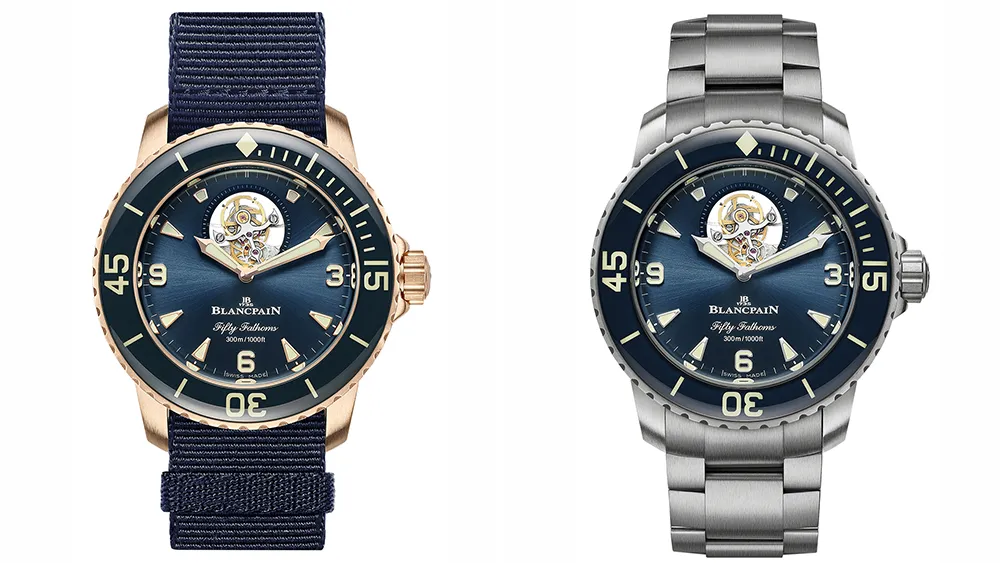
Other historic high-end Swiss brands, such as Rolex, Patek Philippe, Audemars Piguet, and Vacheron Constantin, similarly navigated the crisis by leaning into their established reputations for luxury and exclusivity. They largely retreated from the mass-market battle, concentrating their efforts on the ultra-high end, where craftsmanship, heritage, and brand prestige were paramount.
This strategic pivot was successful because it tapped into a new value proposition. In a world awash with functional and inexpensive quartz watches, mechanical timepieces found renewed appeal by emphasizing what quartz could not readily offer: the human touch of intricate craftsmanship, the narrative of historical lineage, and the perceived “soul” of a complex, living machine. It was a shift from valuing a watch primarily for its functional utility to appreciating it for its emotional, artistic, and historical resonance.
The Quartz Crisis, therefore, did not eradicate mechanical watches; instead, it forced them into a different, more rarified market segment. This led to a clear and enduring bifurcation of the watch market: one segment dominated by mass-market quartz watches, prized for their affordability, accuracy, and convenience, and another characterized by luxury mechanical watches, sought after for their craftsmanship, heritage, and status. Paradoxically, the very “obsolescence” of mechanical technology in terms of pure timekeeping efficiency became an integral part of its charm and luxury appeal. Owning a mechanical watch transformed into a conscious choice, a statement of appreciation for something beyond mere function – a tangible connection to tradition and artistry in an increasingly intangible world.
How the Quartz Crisis Reshaped Timekeeping
The tremors of the Quartz Crisis have left an indelible mark on the horological landscape, fundamentally reshaping not just the Swiss watch industry but the global perception and production of timekeeping devices. Its most significant legacy is the establishment of a distinct dual market structure that persists to this day. On one hand, affordable, highly accurate, and often feature-rich quartz watches cater to the mass market, providing reliable timekeeping for everyday use. On the other, luxury mechanical watches thrive, valued for their intricate craftsmanship, rich heritage, complex engineering, and status as objects of art and personal expression.
The crisis also acted as a powerful catalyst for industry consolidation. The near-collapse of numerous independent Swiss firms led to the formation of large, powerful watchmaking conglomerates, most notably The Swatch Group, born from the merger of ASUAG and SSIH , and later, groups like Richemont. These conglomerates now own a multitude of individual brands, enabling streamlined production, centralized movement supply (like ETA within Swatch Group), and more potent global marketing strategies.
The economics of watch production were also transformed. While the “Swiss Made” label and high-end assembly for luxury mechanicals largely remained anchored in Switzerland to preserve their prestige and quality perception, the crisis accelerated the globalization of mass-market watch and component manufacturing. Production, particularly for quartz movements and affordable watches, increasingly shifted to Asia – initially Japan, then Hong Kong, Taiwan, and China – leveraging lower labor costs and advanced electronics manufacturing capabilities to further drive down prices for consumers.
Innovation did not cease with the end of the crisis; rather, it continued vigorously in both market segments. Quartz technology itself has seen remarkable advancements beyond basic timekeeping. This includes ultra-high-accuracy movements (like Citizen’s Caliber 0100, accurate to ±1 second per year ), solar-powered watches, sophisticated multi-function digital displays, and the integration of new complications even in high-end quartz offerings from brands like Grand Seiko. Furthermore, the foundational technology of quartz paved the way for the development of smartwatches, the latest wave of wrist-worn technological disruption. Simultaneously, the mechanical watch segment experienced a renaissance of innovation, with a renewed focus on haute horlogerie, the development of novel materials, increasingly complex complications, and avant-garde designs.
Perhaps one of the most profound changes was in consumer perception. For many, watches evolved from being purely utilitarian time-tellers into multifaceted objects: fashion accessories, statements of personal style, symbols of achievement or status, and tangible expressions of an appreciation for fine engineering and artistry. The crisis inadvertently fostered a dynamic where the democratization of accurate time via affordable quartz existed alongside the heightened exclusivity and desirability of traditional watchmaking as a luxury good.
This democratization of accurate time is a crucial, often overlooked, legacy. Quartz technology, pioneered and mass-marketed effectively by companies like Seiko, made precise timekeeping accessible to virtually everyone, regardless of wealth – a significant departure from the era when accuracy was a hallmark of expensive mechanical pieces.
The Swiss watch industry’s survival and subsequent revival offer a compelling narrative of resilience through adaptation and redefinition. It did not survive by defeating quartz technology but by strategically adapting to its pervasive presence and fundamentally redefining the value proposition of its traditional mechanical product. In an interesting turn, the mass adoption of quartz watches, by making wrist-worn devices ubiquitous, may have indirectly helped sustain a “watch-wearing culture” that luxury mechanicals could then tap into. Moreover, the immense commercial success of the Swatch directly provided the financial resources necessary to revive and reinvest in the prestigious mechanical brands housed within The Swatch Group, creating a symbiotic relationship born from crisis.
Conclusion
The journey through the Quartz Crisis is a dramatic saga of horological history: from the serene heights of Swiss dominance and the shocking advent of a disruptive technology, through years of turmoil and near-extinction, to a remarkable rebirth that has forged a transformed, and arguably more diverse, watchmaking world.
The crisis offers timeless lessons that resonate far beyond the clinking of tiny gears or the silent pulse of a crystal. It underscores the inherent dangers of complacency, even for industries at their zenith. It vividly illustrates the transformative, and often ruthless, power of disruptive innovation to reshape established markets. Crucially, it highlights the paramount importance of strategic adaptation, visionary leadership, and the courage to redefine value in the face of existential threats. The Swiss watch industry did not merely survive; it reinvented itself by understanding what unique value it could still offer in a changed world.
Today, the allure of horology remains potent. Whether it’s the astonishing precision and practicality of a modern quartz timepiece or the intricate artistry and soulful ticking of a mechanical masterpiece, the human fascination with devices that measure and mark the passage of time endures. The Quartz Crisis, in its crucible of challenge and change, did not diminish this fascination. Instead, it broadened its scope, clarified its expressions, and ultimately bequeathed an industry more resilient, more varied, and perhaps more attuned to the multifaceted ways we value time itself. It stands as a classic, compelling case study in business, innovation, and the enduring strength found in the willingness to evolve.
Related posts
The Rise and Fall of American Watchmaking: A Complete History
American watch manufacturing once dominated global timekeeping, pioneering mass production techniques that revolutionized industry worl...
The Evolution of the Rolex Datejust: 1945-1990
The Rolex Datejust revolutionized wristwatches in 1945 as the world's first self-winding waterproof chronometer with an automatically c...
The Ultimate Guide to Vintage Omega Seamasters
Vintage Omega Seamasters represent one of the most compelling propositions in watch collecting today - offering military provenanc...
The Expert’s Guide to Rolex Serial Numbers and Reference Numbers
Understanding Rolex serial numbers is essential for any Rolex enthusiast, collector, or potential buyer. These unique identif...
The Collector’s Guide to Vintage Wittnauer Chronographs
Vintage Wittnauer chronographs represent one of the most compelling value propositions in the world of mid-century timepieces. While br...
Wittnauer Pert-o-Graph Ref. 7005: An Analog Computer for the Project Manager’s Wrist
Wittnauer Pert-o-graph, tool watch or something else? In the history of horology, the "tool watch" has traditionally been defined by it...
The Expert’s Guide to Buying Vintage Watches on eBay In 2025
eBay, to the aspiring watch collector, is a landscape of profound contradiction. It is a digital bazaar of immense scale, a place where...
Complete Guide to the Rolex Datejust 1601
In the grand pantheon of horology, few timepieces command the same blend of understated elegance, historical significance, and everyday...
How the Quartz Crisis Nearly Ended Swiss Watchmaking
Before the quartz crisis (1970s), the Swiss watchmaking industry stood as an unshakeable colossus, a global symbol of precision, intric...
An Expert’s Guide to Omega Reference Numbers
Omega's rich horological history, stretching back to 1848, has produced an astonishingly diverse and extensive catalogue of timepieces....
Patina vs. Damage on a Watch Dial
Among vintage watch enthusiasts and collectors, one of the most debated topics revolves around patina and damage. What sets the two apa...
How Old Is My Bulova Watch? Production Date Guide
Bulova, one of the first companies to mass-produce wristwatches in the early 20th century, has made it easier than most to identify the...

